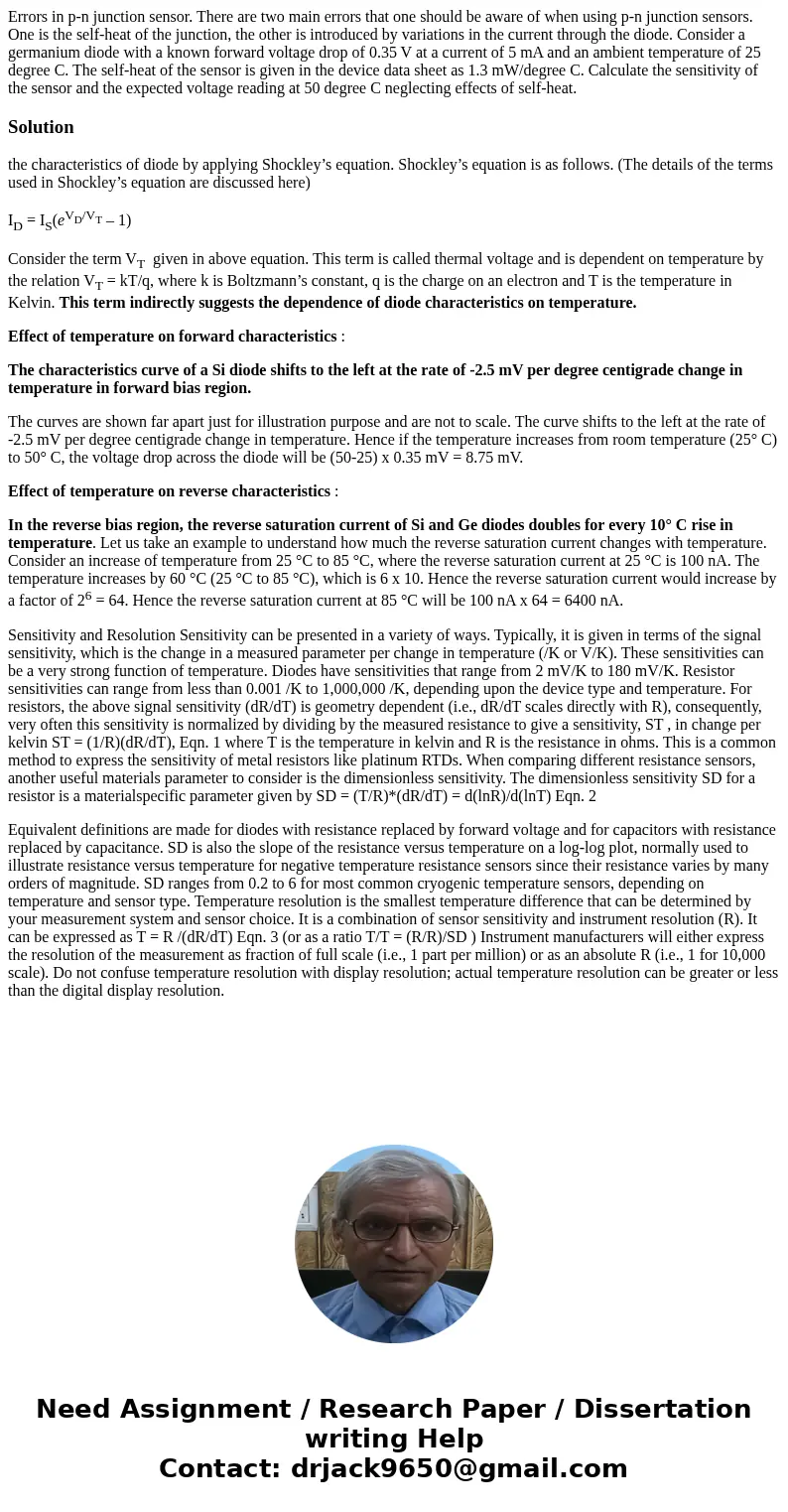Errors in pn junction sensor There are two main errors that
Solution
the characteristics of diode by applying Shockley’s equation. Shockley’s equation is as follows. (The details of the terms used in Shockley’s equation are discussed here)
ID = IS(eVD/VT – 1)
Consider the term VT given in above equation. This term is called thermal voltage and is dependent on temperature by the relation VT = kT/q, where k is Boltzmann’s constant, q is the charge on an electron and T is the temperature in Kelvin. This term indirectly suggests the dependence of diode characteristics on temperature.
Effect of temperature on forward characteristics :
The characteristics curve of a Si diode shifts to the left at the rate of -2.5 mV per degree centigrade change in temperature in forward bias region.
The curves are shown far apart just for illustration purpose and are not to scale. The curve shifts to the left at the rate of -2.5 mV per degree centigrade change in temperature. Hence if the temperature increases from room temperature (25° C) to 50° C, the voltage drop across the diode will be (50-25) x 0.35 mV = 8.75 mV.
Effect of temperature on reverse characteristics :
In the reverse bias region, the reverse saturation current of Si and Ge diodes doubles for every 10° C rise in temperature. Let us take an example to understand how much the reverse saturation current changes with temperature. Consider an increase of temperature from 25 °C to 85 °C, where the reverse saturation current at 25 °C is 100 nA. The temperature increases by 60 °C (25 °C to 85 °C), which is 6 x 10. Hence the reverse saturation current would increase by a factor of 26 = 64. Hence the reverse saturation current at 85 °C will be 100 nA x 64 = 6400 nA.
Sensitivity and Resolution Sensitivity can be presented in a variety of ways. Typically, it is given in terms of the signal sensitivity, which is the change in a measured parameter per change in temperature (/K or V/K). These sensitivities can be a very strong function of temperature. Diodes have sensitivities that range from 2 mV/K to 180 mV/K. Resistor sensitivities can range from less than 0.001 /K to 1,000,000 /K, depending upon the device type and temperature. For resistors, the above signal sensitivity (dR/dT) is geometry dependent (i.e., dR/dT scales directly with R), consequently, very often this sensitivity is normalized by dividing by the measured resistance to give a sensitivity, ST , in change per kelvin ST = (1/R)(dR/dT), Eqn. 1 where T is the temperature in kelvin and R is the resistance in ohms. This is a common method to express the sensitivity of metal resistors like platinum RTDs. When comparing different resistance sensors, another useful materials parameter to consider is the dimensionless sensitivity. The dimensionless sensitivity SD for a resistor is a materialspecific parameter given by SD = (T/R)*(dR/dT) = d(lnR)/d(lnT) Eqn. 2
Equivalent definitions are made for diodes with resistance replaced by forward voltage and for capacitors with resistance replaced by capacitance. SD is also the slope of the resistance versus temperature on a log-log plot, normally used to illustrate resistance versus temperature for negative temperature resistance sensors since their resistance varies by many orders of magnitude. SD ranges from 0.2 to 6 for most common cryogenic temperature sensors, depending on temperature and sensor type. Temperature resolution is the smallest temperature difference that can be determined by your measurement system and sensor choice. It is a combination of sensor sensitivity and instrument resolution (R). It can be expressed as T = R /(dR/dT) Eqn. 3 (or as a ratio T/T = (R/R)/SD ) Instrument manufacturers will either express the resolution of the measurement as fraction of full scale (i.e., 1 part per million) or as an absolute R (i.e., 1 for 10,000 scale). Do not confuse temperature resolution with display resolution; actual temperature resolution can be greater or less than the digital display resolution.

 Homework Sourse
Homework Sourse